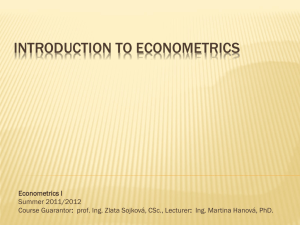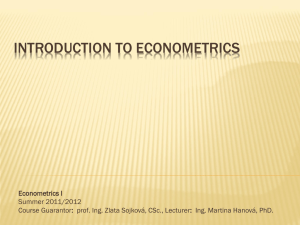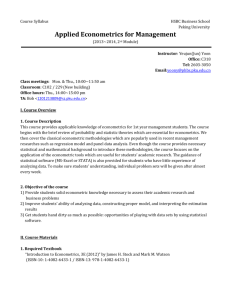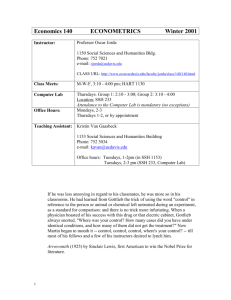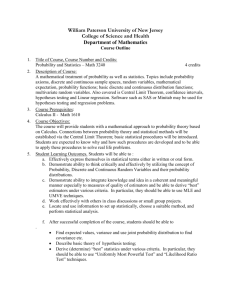Introduction to Econometrics
advertisement
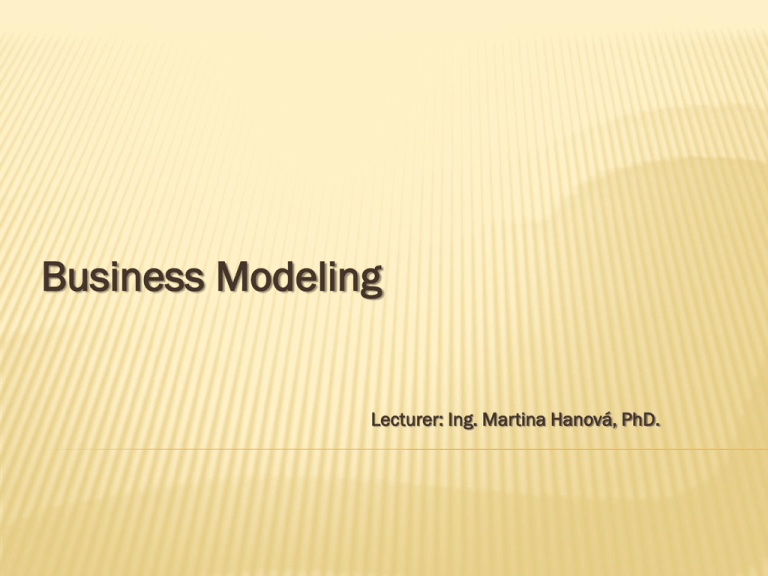
Business Modeling Lecturer: Ing. Martina Hanová, PhD. ECONOMETRICS „Econometrics may be defined as the social science in which the tools of economic theory, mathematics, and statistical inference are applied to the analysis of economic phenomena.“ (Arthur S. Goldberger) ECONOMETRIC THEORY Econometrics - uses a variety of techniques, including regression analysis to compare and test two or more variables. Mathematics Statistics Econometrics Economics Econometrics is a mixture of economic theory, mathematical economics, economic statistics, and mathematical statistics. METHODOLOGY OF ECONOMETRICS Traditional or classical methodology 1. Statement of theory or hypothesis 2. Specification of the mathematical model 3. Specification of the statistical, or econometric model 4. Obtaining the data 5. Estimation of the parameters of the econometric model 6. Hypothesis testing 7. Forecasting or prediction 8. Using the model for control or policy purposes. 1. THEORY OR HYPOTHESIS A theory should have a prediction – hypothesis (in statistics and econometrics) Keynesian theory of consumption: Keynes stated - men are disposed to increase their consumption as their income increases, but not as much as the increase in their income. marginal propensity to consume (MPC) - is greater than zero but less than 1. 2. MATHEMATICAL MODEL Mathematical equation: Y = β1 + β2X β1 intercept and β2 a slope coefficient. THEORY: Return to schooling is positive Y = wage X = number of years in school Keynesian consumption function: Y = consumption expenditure X = income β2 measures the MPC 0 < β2 < 1 3. SPECIFICATION OF THE ECONOMETRIC MODEL Mathematical model - deterministic relationship between variables Y = β1 + β2X + u Econometric model – random or stochastic relationship between variables Y = β1 + β2X + u or - disturbance, error term, or random (stochastic) variable - represents other non-quantifiable, unknown factors that affect Y, also represents mismeasurements EXAMLE: relationship between Crop yield vs. Rain fall 4. OBTAIN DATA observational data non-experimental data, experimental data Types of Data time series data cross-section data pooled data Measurement of Scale Ratio scale Interval scale Ordinal scale Nominal scale 5. ESTIMATION OF THE MODEL to estimate the parameters of the function, β1 and β2, Regression analysis - statistical technique - the single most important tool at the econometrician’s disposal Ŷ = −184.08 + 0.7064X Ŷ - is an estimate of consumption 6. HYPOTHESIS TESTING Statistical inference (hypothesis testing) We can use the information in the sample to make inferences about the population. We will have two hypotheses that go together, H0: the null hypothesis H1:the alternative hypothesis The null hypothesis is the statement or the statistical hypothesis that is actually being tested. The alternative hypothesis represents the remaining outcomes of interest. 7. FORECASTING forecast, variable Y on the basis of known or expected future value(s) of the explanatory, or predictor, variable X. 8. USE FOR POLICY RECOMMENDATION TERMINOLOGY AND NOTATION Dependent variable Explained variable Predictand Regressand Response Endogenous Outcome Controlled variable Independent variable Explanatory variable Predictor Regressor Stimulus Exogenous Covariate Control variable two-variable (simple) regression analysis multiple regression analysis multivariate regression vs. multiple regression DETERMINING THE REGRESSION COEFFICIENTS FINDING A LINE OF BEST FIT We can use the general equation for a straight line, to get the line that best “fits” the data. y x ORDINARY LEAST SQUARES (OLS) The most common method used to fit a line to the data is known as OLS (ordinary least squares). Actual and Fitted Value y yi û i ŷi xi x THE THEORY OF OLS E(YiXi) = o + 1Xi population regression line (PRF) Ŷ i = b o + b 1X i sample regression equation (SRF) min ei2 = e12 + e22 + e32 +.........+ en2 HOW DOES OLS GET ESTIMATES OF THE COEFFICIENTS? Excel Tools/data analysis/ regression Matrix form Formula – mathematical function n b1 n. Yi X i i 1 n n. X i 1 n Y X i 1 i i 1 Xi i 1 n 2 i n n 2 i b0 n n n X Y X X Y i 1 2 i i 1 i i 1 i n 2 n. X i X i i 1 i 1 n i i i 1 2 RESULTS Interpretation of the regression output: R Square – Multiple R – Standard Error of the regression Intercept – Regression Coefficient –
